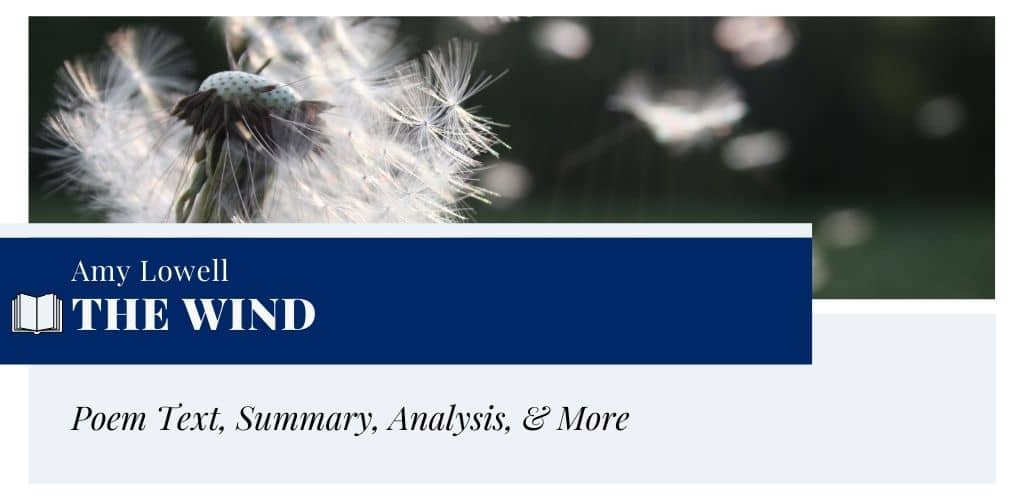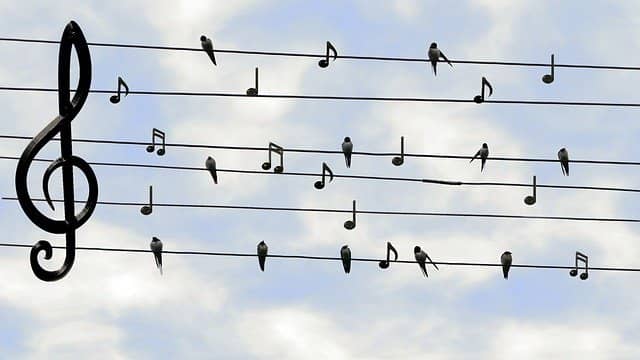The Wind by Amy Lowell
“The Wind” is written by the American poet of the imagist school, Amy Lowell. This poem explores the positive side of the wind that blows around. In this poem, Lowell personifies it as a playful boy. She describes why she likes it through this poem. In order to portray its impact on the surroundings, she uses vivid imagery. The musicality of the poem alongside the repetition at the end of each stanza makes it an interesting read.
- Read the full text of “The Wind” below:
The Wind by Amy Lowell He shouts in the sails of the ships at sea, He steals the down from the honeybee, He makes the forest trees rustle and sing, He twirls my kite till it breaks its string. Laughing, dancing, sunny wind, Whistling, howling, rainy wind, North, South, East and West, Each is the wind I like the best. He calls up the fog and hides the hills, He whirls the wings of the great windmills, The weathercocks love him and turn to discover His whereabouts — but he's gone, the rover! Laughing, dancing, sunny wind, Whistling, howling, rainy wind, North, South, East and West, Each is the wind I like the best. The pine trees toss him their cones with glee, The flowers bend low in courtesy, Each wave flings up a shower of pearls, The flag in front of the school unfurls. Laughing, dancing, sunny wind, Whistling, howling, rainy wind, North, South, East and West, Each is the wind I like the best.

Summary
In the beginning, Lowell addresses the wind as “He”. By investing life, she wants to portray it as a cheerful boy wandering about nature. He shouts in the sails and steals pollens from the honeybees. When he moves through the forest, it makes trees sing with him. Sometimes when the speaker flies a kite, he twirls it. No matter how naughty the wind is, the speaker likes it in every form, be it the laughing “sunny wind” or the howling “rainy wind”.
In the following stanza, she describes how it calls up the fog and covers the hills. He makes the windmills and the weathercocks whirl. Like a rover, he does not stay in one place. Furthermore, he has a good relationship with the trees and flowers with whom he plays. The pine trees offer their cones in joy and the flowers bend in courtesy. When he flies over the sea, the waves fling up a shower of pearls. The flag in front of the school unfurls when he blows. In this way, Lowell describes her liking towards the personified wind and repeats that she likes it the best.
Form, Rhyme Scheme, & Meter
“The Wind” consists of three stanzas. Each stanza consists of eight lines. The lines can be grouped into two quatrains. Lowell uses the AABBCCDD rhyme scheme. It means two consecutive lines form a rhyming couplet. For example, in the first two lines “sea” and “honeybee” rhyme. The same pattern can be found in the following lines. Regarding the meter, this poem is composed of the iambic tetrameter. It means there are four iambic feet per line. Besides, the fifth, sixth and seventh lines of each stanza contain trochees and spondees.
Poetic Devices & Figurative Language
Lowell uses the following poetic devices in her poem “The Wind”.
- Personification: In this poem, Lowell personifies the wind and compares it to a little child. She invests it with the idea of shouting, stealing, singing, etc.
- Refrain: The last four lines of each stanza are used as a refrain. It gives this piece a song-like quality.
- Alliteration: It occurs in “shouts in the sails”, “hides the hills”, “trees toss”, etc.
- Metaphor: Lowell uses a metaphor in “His whereabouts — but he’s gone, the rover!” Here, the wind is compared to a rover or wanderer.
- Anaphora: The first four lines contain this device. These lines begin with the word “he”. It also occurs in the first two lines of the following stanzas.
Stanza-by-Stanza Analysis & Explanation
Stanza One
He shouts in the sails of the ships at sea,
He steals the down from the honeybee,
He makes the forest trees rustle and sing,
He twirls my kite till it breaks its string.
Laughing, dancing, sunny wind,
Whistling, howling, rainy wind,
North, South, East and West,
Each is the wind I like the best.
Amy Lowell’s poem begins with a reference to the wind as a human being. Lowell compares it with a frolicking boy. He shouts in the sails of the ships. Here, the sound of the wind blowing the sails is compared to shouting. When it blows, it unsettles the flowers’ anthers. The poet thinks as if the wind steals the down, a reference to the tiny hairs on the anthers. In this way, it teases the honeybees hovering over flowers in search of honey.
While it blows through the forest trees, it makes them rustle. This rustling sound of trees is compared to a song. It is the song of the wind. Besides, when the speaker flies her kite, the wind comes and twirls it. It does so until the string breaks. However, the wind’s act is not at all annoying to the speaker.
According to her, she loves both the “sunny wind” and the “rainy wind”. She describes the former as laughing and dancing. The latter is described as whistling and howling. During a sunny day, the wind is cheerful. Hence, she describes it by these terms. While, during a rainy day, it blows harder by making a howling sound.
In the last two lines, the poet says that she likes the north, south, west, and east winds. Each type of wind has its own beauty.
Stanza Two
He calls up the fog and hides the hills,
He whirls the wings of the great windmills,
The weathercocks love him and turn to discover
His whereabouts — but he’s gone, the rover!
Laughing, dancing, sunny wind,
Whistling, howling, rainy wind,
North, South, East and West,
Each is the wind I like the best.
In the second stanza, the poet describes how the wind calls up the fog and hides the hills. The wings of the great windmills are whirled by its very existence. Besides, the weathercocks at the top of houses move when it blows. They move to discover its course.
However, none can find where he goes. He comes for a while and vanishes within a flash of a second. The poet describes its uncertainty as that of a rover or wanderer. In this line, the poet uses a rhetorical exclamation in order to portray her amazement concerning the wind’s carefree nature.
The last four lines of this stanza act as a refrain. It is used to emphasize the poet’s fondness for the wind.
Stanza Three
The pine trees toss him their cones with glee,
The flowers bend low in courtesy,
Each wave flings up a shower of pearls,
The flag in front of the school unfurls.
Laughing, dancing, sunny wind,
Whistling, howling, rainy wind,
North, South, East and West,
Each is the wind I like the best.
In the last stanza, the poet describes the relationship of the wind with the pine trees and flowers. Whenever the wind blows, the pine trees toss their cones. It seems to the poet as if the trees become joyous in the wind’s presence. So they toss their cones as tokens of friendship.
The flowers are personified in the following lines. When the wind passes by, it makes the flowers bend low. The poet thinks as if they are bowing to it in courtesy.
In the next line, there is a metaphor in the phrase “shower of pearls”. Here, the drops of water are compared to pearls. Lowell depicts how the wind blows over the sea by flinging up a “shower of pearls”. Besides, it makes the flag in front of the speaker’s school unfurl. The last four lines are repeated similarly.
In this way, the poet depicts the positive ideas associated with the wind throughout the poem. The way it makes everything cheerful also makes her heart happy. That’s why she likes it the most.
Historical Context
“The Wind” was written in the early 20th century. Amy Lawrence Lowell belonged to the imagist school. Her first work “Fireworks” was published in 1915 in Atlantic Monthly. In her poems, readers can find the features associated with imagism. For example, in this poem, she beautifully captures the movement of the wind by using kinesthetic imagery. She also uses visual imagery in order to portray the scenes. Besides, the auditory images convey the sound of the wind. Her sensibility to nature is present in this piece.
Questions & Answers
The poem is about the positive features of the wind and how it influences the poet’s mind. She describes it as a playful child who wanders about and makes everything cheerful on its way.
The poet personifies the wind as a child. She addresses it with the pronoun “He” and invests masculinity into this natural phenomenon.
It is a lyric poem written in a regular rhyme scheme and meter. It contains the AABB rhyme scheme.
The speaker of this poem is the poet Amy Lowell herself. She speaks in this piece through her poetic persona.
The main themes of this poem include playfulness of the wind, nature, joy, and wandering.
Similar Poems about the Wind
- “The Wind” by Robert Louis Stevenson — This piece is about a child’s reaction to the mighty wind.
- “The Starry Night” by Anne Sexton — In this poem, Sexton introspects on specific aspects of Vincent van Gogh’s painting.
- “Windy Nights” by Robert Louis Stevenson — This piece features the stormy wind as a horse rider.
External Resources
- Poet Profile & Poems of Amy Lowell — Explore the poet’s profile and her best-known poems.
- About Amy Lowell — Learn more about the poet.
- Life & Career of Amy Lowell — Read more about the poet’s life and literary career.


